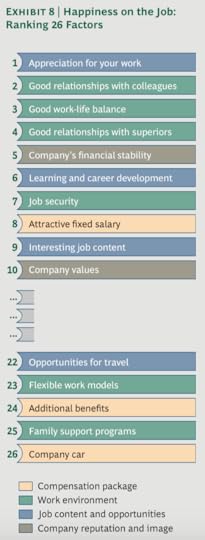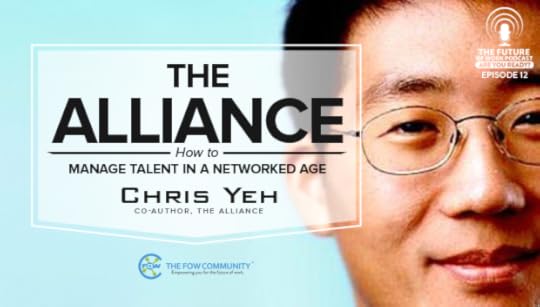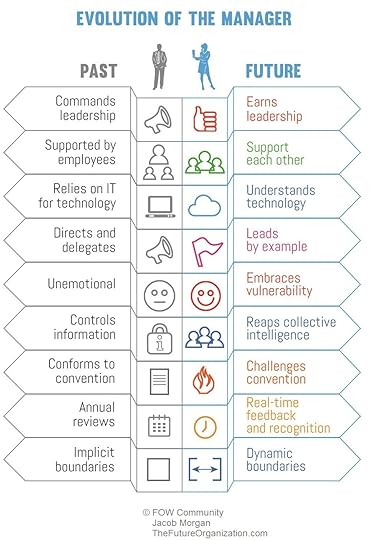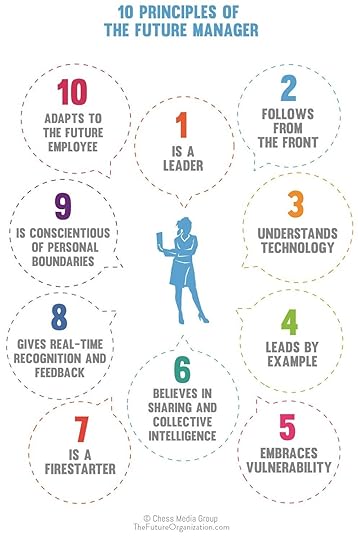Jacob Morgan's Blog, page 28
December 9, 2014
What the Future of Work Will NOT Look Like
We spend a lot of time exploring what the future of work is going to look like (myself included). However, it’s helpful to take a step and examine some of the outdated practices and ways of thinking about work that WON’T be coming with us. That’s exactly what this video is about. Commuting to and from the office, annual employee reviews, relying on managers to make all the decisions, and the like, are all examples of things will go the way of the dodo bird.
Enjoy this latest episode of the Future in 5!
 Send to Kindle
Send to KindleThe post What the Future of Work Will NOT Look Like appeared first on .





December 8, 2014
New Research: The Top 10 Factors for Employee Happiness on the Job
 Employee engagement and happiness is definitely one of the topics du jour for modern management and the future of work. Plenty of studies have already (and continue to) come out that show how low employee engagement is around the world (only 13% of employees are engaged and 87% are not!). Low employee engagement numbers correlate and oftentimes cause decreased productivity, waisted resources, and an overall toxic environment that nobody wants to be a part of…and why should they?
Employee engagement and happiness is definitely one of the topics du jour for modern management and the future of work. Plenty of studies have already (and continue to) come out that show how low employee engagement is around the world (only 13% of employees are engaged and 87% are not!). Low employee engagement numbers correlate and oftentimes cause decreased productivity, waisted resources, and an overall toxic environment that nobody wants to be a part of…and why should they?
This is why it’s important to understand what employees around the world value in their jobs. So what do employees actually want and what do they care about?
A Tinypulse survey from 2013 revealed that transparency was the #1 factor for employee engagement
A 2014 SAP survey found that compensation is the #1 factor that matters most to employees
Another survey by the SHRM (Society for Human Resource Management) conducted in 2013 also found that compensation and pay was the #1 factor contributing to job satisfaction
Several other studies have also emerged around what employees care about at work but the most recent one from Boston Consulting Group which surveyed over 200,000 people around the world is one of the most comprehensive. Unlike previous studies which may point to flexibility or salary as the top factor for job happiness, BCG found that the #1 factor for employee happiness on the job is get appreciated for their work!
Based on the color coded categories you can see in the sidebar, out of the top factors the majority are grouped as either “work environment” or “job content and opportunities.” Perhaps what is more interesting is the contrary to some of the other studies which show compensation as the #1 factor for happiness, this report puts salary at #8. This reaffirms what I consistently see in organizations that I speak with. You can’t pay someone a lot of money, treat them poorly, and expect them to do their jobs well just because they get a nice check.
It’s important to remember that the “balance of power” is shifting away from organizations and towards employees. Today, we have a lot of choices to consider and several opportunities to evaluate when exploring how to make a living. Instead of going to work for a large established company that has more money, people can now:
join a small growing startup
become a freelancer on sites like odesk or elance
drive for Uber or Lyft
create their own products to sell on sites like Etsy
raise money through crowd-funding on sites like Indiegogo or Kickstarter
and much more
The war for talent has never been greater so in a world where cash is no longer the #1 factor attracting employees to organizations, these organizations must focus on other factors to create a more desirable and engaging place to work. What do you think of these recent number? Are you shocked or surprised to see that compensation is #8?
 Send to Kindle
Send to KindleThe post New Research: The Top 10 Factors for Employee Happiness on the Job appeared first on .





December 4, 2014
Evolution of The Manager
This concept and the visual was taken from my new book, The Future of Work: Attract New Talent, Build Better Leaders, and Create a Competitive Organization.
A few months ago I introduced the concept of the 7 Principles of the Future Employee which was followed by The Evolution of the Employee. I’m taking this same approach (principles and evolution) and applying it to managers as well. Last week I shared the 10 Principles of the Future Manager so it’s only fitting that we now get to the evolution of the manager as seen below.
Based on the above these are the key things to pay attention to.
Managers must be leaders
There’s a constant debate around whether we need more managers or more leaders. Sadly this is a fruitless debate that artificially pits the two against each other. When thinking about the future of work managers MUST be leaders. That is, they are placed in a position of power because they have earned followers, thought leadership, and respect. If a manager is simply placed in a position of power because they are able to bring in the most money or are experts at delegating then they will fail. It’s time we stop referring to managers and leaders as two separate people. If you haven’t earned leadership then you shouldn’t be a manager.
Managers must understand the trends shaping the future of work
These five trends were explored in a previous article called, The Five Trends Shaping the Future of Work but to recap them here they are: mobility, globalization, new behaviors, millennials (demographics), and technology. Managers must successfully understand what these five trends are and how they are going to impact their respective organizations. These trends are the basic building blocks (the DNA) of the future of work.
Managers must embrace vulnerability
We can no longer have managers in the workplace that resemble robots. It’s bad enough that there is quite a bit of concern around actual robots taking jobs away from humans, the last thing we need are humans that act like robots. It makes me think of the saying, “I’m not a doctor but I play one on t.v.” – applied to managers this would be “I’m not a robot but I play one in the workplace.” Brene Brown said it best when she quipped that there is no innovation without vulnerability. This is because people want to build relationships with other…people. This requires trust and a human connection. When managers put up a wall of being stoic, all-knowing, emotionless beings, they kill off any hope of innovation, trust, and connection. Managers embracing vulnerability in the workplace isn’t important because it’s a nice thing to do but because it’s crucial for effective communication, collaboration, and innovation.
Managers must challenge convention
Why is it that we constantly hear about managers that are “putting out fires?” Managers must be the fire-starters! That is, they must be constantly thinking of ways that they can challenge the assumptions that we have around how work gets done. Should managers make all the decisions? Do we need annual employee reviews? Can anyone in the company be a leader? Should innovation be a core skill taught to all employees? Can the organization set up a pool of experimental capital that can be used to test out new ideas? These are the types of questions and ideas that managers should be thinking about. Today, their stereotypical role focuses on constraint, control, order, diligence, and sticking with the common assumptions that have long guided how we work. Instead, managers must heed the word of the band Prodigy to become “fire-starters.”
Managers of the future are very different than managers of the past, they must evolve.
 Send to Kindle
Send to KindleThe post Evolution of The Manager appeared first on .





December 2, 2014
Are You Focusing on the ‘Big Rocks?’
Understanding how the world of work is changing and what trends are shaping the future of work is only a part of what organizations need to focus on. Of course, to take this to the next level some kind of action needs to take place. However, what I’m finding time and time again is that many organizations today are not focusing on the “big rocks.” Now to fully understand this analogy you will have to watch the video below. The gist of the idea I’m trying to get across is to move beyond focusing on the superficial elements that might impact your organization and to instead focus on the core first. For example, many companies are experimenting with flexible work programs, collaborative technologies, getting rid of annual employee reviews, and the like. Now while these are all great they are the top layer of the future of work. These are the tactics, strategies, and perks that many organizations are focusing on (in the video below this is the gravel, water, and sand).
Instead we need to take a step back and ask ourselves some very basic questions:
What does the future of work at our company look like?
What does it mean to be an employee at our company and will we even have employees in the next decade?
How do we want our managers to lead our organization and who should become a manager?
What kind of corporate culture should we be striving to create and how does it relate to the future of work?
Does our organization even need to have four walls?
These are the “big rocks” we need to focus on first, then we can worry about all the other nice things that go on top of them.
 Send to Kindle
Send to KindleThe post Are You Focusing on the ‘Big Rocks?’ appeared first on .






November 25, 2014
Relying on Offices is so 1990!
 A few weeks ago I had a book launch event in NYC hosted by REGUS. One of the big topics of discussion was all around offices and their role in the future of work. In other words, do we need to continue to rely on offices as the only place where we can get work done? I’m sure by now you know what my stance on this is. Absolutely not, we do not need to rely on offices. Today, as long as we can connect to the internet we are able to get our jobs done regardless of where we are or when we are connected. This means employees can work from home offices, cafes, co-working facilities, or anywhere else they can get wifi.
A few weeks ago I had a book launch event in NYC hosted by REGUS. One of the big topics of discussion was all around offices and their role in the future of work. In other words, do we need to continue to rely on offices as the only place where we can get work done? I’m sure by now you know what my stance on this is. Absolutely not, we do not need to rely on offices. Today, as long as we can connect to the internet we are able to get our jobs done regardless of where we are or when we are connected. This means employees can work from home offices, cafes, co-working facilities, or anywhere else they can get wifi.
I wrote about this topic in much more detail in an article titled “Why We Don’t Need Offices,” where I explored 8 reasons why relying on corporate offices is obsolete. However, I wanted to explore this topic a bit more in a recent episode of The Future in 5!
 Send to Kindle
Send to KindleThe post Relying on Offices is so 1990! appeared first on .






November 20, 2014
10 Principles of The Future Manager
Following up on my post around the 7 Principles of The Future Employee, I wanted to share another concept which is the 10 Principles of The Future Manager. When it comes to the future of work it’s not just employees that are changing, managers are also having to change the ways in which they lead and in fact are HAVING to become leaders. These are 10 core principles or characteristics that managers will and must possess going forward. This image is taken from my book, The Future of Work.
Is a leader
There has long been a distinction between managers and leaders. Managers were the dictators and leaders were the visionaries. Going forward a manager MUST be a leader, that is, he or she must earn followers and not command respect. Being a manager is something you earn not something you are assigned to do. A manager cannot be someone placed in a position of power simply because they bring in the most money or are the best at delegating.
Follow from the front
This concept is all about the manager’s responsibility to remove obstacles from the paths of employees. A manager exists to make his people more successful not to have his or her people serve them. When a manager follows from the front he paves the way and enables team members to become successful.
Understands technology
Managers don’t need to become experts at every new technology that comes their way. However, now that technology has become such a crucial part of how we live and work it has never been more important for managers to grasp which technologies have the potential to benefit the organization and which new technologies might be coming their way in the near future. A manager must a keep a good pulse on technology.
Leads by example
A manager must be the first person to demonstrate a new behavior, to support a relevant technology, or to embrace a new concept. A manager cannot lead by delegating and ordering, a manager can only lead by demonstrating; they are the guinea pigs, the ones on the front line, and the ones who will help drive change.
Embraces vulnerability
A manager need to be ok with asking for help, admitting when they are wrong or when they don’t know something, and will feel comfortable when team members ask questions and voice their opinions even though they may contradict theirs. Embracing vulnerability is what leads to innovation, it’s about bringing down the stereotypical façade that managers are supposed to have (being robots) and being people. We are already talking about robots replacing many human jobs, let’s not jump the gun by having managers act like “human” robots. Managers must be people.
Believes in sharing and collective intelligence
A manager understands and embraces the fact that they may not have all the answers or make the best decisions nor should they want or be expected to. A manager knows that it is far more effective to rely on the collective intelligence of a team instead of the directions of one. This manager also acknowledges the benefit and value in sharing information instead of hoarding it; something that is largely being made possible with collaborative technologies.
Is a fire starter
Managers are oftentimes credited with having to “put out fires,” but their role should be the exact opposite! Managers SHOULD be fire starters; that is sparking ideas, challenging convention, and experimenting.
Gives real time recognition and feed-back
Any manager worth their weight in salt knows that annual reviews are not effective for either the organization or the team members. Instead managers will focus on providing their team with real time feedback and recognition through collaborative technologies and platforms and through regular, short, periodic check-ins instead of multi-hour long reviews.
Is conscientious of personal boundaries
A manager recognizes that team members have their own space, both digitally and physically. This means respecting those boundaries and being aware of when it is appropriate to “friend” someone through social channels, if/when it’s ok to schedule a 6am meeting or a 10 pm presentation, or if it’s ok to send emails or projects through on the weekends or during vacation time. With our ability to always stay connected managers must remember that connectivity doesn’t always imply availability. A manager must work towards setting expectations that boundaries exist and are respected.
These are The 10 Principles of The Future Manager and you can learn more about them and plenty of other concepts around how the workplace is changing by reading my new book, The Future of Work.
 Send to Kindle
Send to KindleThe post 10 Principles of The Future Manager appeared first on .






November 18, 2014
Will Facebook at Work, Work?
Here is the second episode of The Future In 5, the video series where I share my ideas, insights, and commentary on the future of work in five minutes or less!
You may have heard the rumors that Facebook is launching a version of it’s popular social network for businesses to use in the workplace! In this episode of TheFuturein5 I share my thoughts on why I think Facebook has a strong opportunity to dominate this market but I also highlight some of the key challenges that they will have to overcome in order to become successful in the enterprise collaboration space. This has the potential to dramatically impact both consumers and businesses! If you want to get all the latest videos from me on the future of work then make sure to subscribe to the Youtube channel!
 Send to Kindle
Send to KindleThe post Will Facebook at Work, Work? appeared first on .






November 17, 2014
Are You Spending Too Much Time Focusing On Millennials?
Here is the first episode of The Future In 5, the video series where I share my ideas, insights, and commentary on the future of work in five minutes or less! In this episode I talk about millennials in the workplace and if some organizations might be spending a bit too much time focusing on this one generation. If you want to get all the latest videos from me on the future of work then make sure to subscribe to the Youtube channel!
 Send to Kindle
Send to KindleThe post Are You Spending Too Much Time Focusing On Millennials? appeared first on .






November 14, 2014
Introducing The Future In 5, a New Video Series on The Future of Work!
I’m very excited to announce a new video series I’m launching called The Future in 5. For each episode I will be sharing my thoughts, ideas, and commentary on the future of work in five minutes or less. My goal is to provide content in a more fun, interactive, and casual way to engage with my community more effectively. I will try to do a new video every day if I can! Here’s an introduction to what this show is all about, make sure to visit The Future in Five page to subscribe!
 Send to Kindle
Send to KindleThe post Introducing The Future In 5, a New Video Series on The Future of Work! appeared first on .






November 13, 2014
The Alliance – Managing Talent In a Networked World
Click Here to Subscribe via iTunes
Click Here to Subscribe via RSS Feed (non-iTunes feed)

http://traffic.libsyn.com/futureofworkpodcast/podcast__Guest_Chris_Yeh_Done.mp3
What this episode is about and why you should care
In a world where employee tenure is shrinking and where independent workers are on the rise, organizations are struggling to find a new way of working with employees. Employees in the meantime are thinking of ways they can develop their careers while always keeping an eye on “the next best opportunity” to come their way. Clearly there is a challenge for businesses today when it comes to trust in loyalty. So, is there a solution that can benefit both parties? One approach is to use the concepts outlined in a recent book called The Alliance which focuses on “tours of duty” or rotational periods of employment. During a tour of duty an employee commits to completing something for the employer and the employer commits to helping the employee advance their career, learn new skills, grow their network, etc. To learn more about the “tour of duty” along with other concepts from The Alliance, I invited Chris Yeh to join me on The Future of Work Podcast.
What you will learn in this episode
What is a “Tour of Duty” and how long do they last?
What are some ways to maintain employee engagement?
What are ways that businesses can utilize and build alliances?
How does trust play a role in the business world?
What are the different classifications of the Tour of Duty
What approach you can use to increase employee retention
Understanding of the role managers pay in an organization
Learn the framework that will help you retain employees
What employees can do to build an Alliance
What employers can do to build an Alliance
 Send to Kindle
Send to KindleThe post The Alliance – Managing Talent In a Networked World appeared first on .











